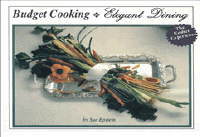|
Orejas
de Haman
Hamantashen
from the Sephardic tradition.
Haman's Ears
 The
Sephardic Kitchen
: The
Healthy Food and Rich Culture of the Mediterranean Jews by Robert Sternberg
,1996. The
Sephardic Kitchen
: The
Healthy Food and Rich Culture of the Mediterranean Jews by Robert Sternberg
,1996.
The definitive
book on the foods, menus, celebrations, and lore of the Mediterranean
Jews, this book will be a mainstay of Jewish-American cooks of all backgrounds.
|
|
These
are a well-known Sephardic Purim confection. They are made to resemble
the shape of a human ear, in this case the ear of Haman, who was defeated
in his attempt to murder the Jews of Persia by wise Queen Esther and her
uncle Mordecai. It is good that orejas de haman are made only once
a year because being deep fried and then soaked in a rich sugar syrup
they are not fare for the girth-conscious!
Preparation
time: 1 1/2 hours. Yield: makes about 25-30 orejas de haman
1
1/2 cups sugar
1 1/3 cups cold water
2 tablespoons orange flower water
3 large eggs
pinch salt
1/2 cup freshly squeezed orange juice
Finely grated zest of 1 orange
1/2 cup confectioner" sugar
2 cups unbleached white pastry flour
1/4 cup slivered almonds
Peanut oil for deep frying
1.
Prepare the syrup by dissolving 1 1/2 cups sugar in 1 1/3 cups cold water
in a saucepan. Bring to a boil and cook until the syrup is thick enough
to coat the back of a spoon. Remove it from the heat, stir in the orange
flower water and set it aside to cool.
2.
Beat the eggs well until frothy in a large mixing bowl. Add the salt,
orange juice and zest, and confectioners' sugar.
3.
Mix in the flour and slivered almonds. Knead the dough on a floured board
or use the dough hook of a standing mixer for 10 minutes.
4.
Roll the dough to a 1/2 inch thickness and cut into 4-inch rounds with
a wide glass cookie cutter.
5.
Cut each circle in half. Draw the two pointed ends of each half circle
together and pinch them to form a small hump in the center which buckles
up a little. This piece of dough is now shaped to roughly resemble an
ear.
6.
Heat peanut oil in a wok to a depth of 2 inches or in a deep fryer to
a depth of 3 inches. Fry the pastries a few at a time until they are golden
brown in color. Drain on paper towels. Do not crowd the pastries. They
will puff out a little as they fry.
7.
When you have finished frying and draining all the pastries, arrange them
on a long platter and drizzle the syrup over them. Let cool and then serve.
Fattening and delicious!
|
Hamantashen
 The
Book of Jewish Food
: An Odyssey from Samarkand to New York by Claudia Roden,1996. The
Book of Jewish Food
: An Odyssey from Samarkand to New York by Claudia Roden,1996.
A history of the Jewish diaspora told through its cuisine.
The book's 800 recipes reflect many cultures and regions of the
world, from the Jewish quarter of Cairo where Roden spent her
childhood to the kitchens of Europe, Asia, and the Americas. Both
Ashkenazi and Sephardic cooking are well represented.
|
|
Makes
about 20
At
Purim, to celebrate the demise of the hated Haman, the Sephardim
make pastries in the shape of his ears and the Ashkenazim make
pastries in the shape of his 3-cornered hat. There are different
types of dough, including a yeast dough, This biscuity one is
meltingly delicious. There are various fillings. The most traditional
and most popular is a poppy-seed one. Another is with prunes.
For
the dough
1
3/4 cups (250 g) flour
A pinch of salt
2 tablespoons sugar
2 or 3 drops vanilla extract
5 oz (150 g) unsalted butter
1 egg yoke
2-3 teaspoons milk, if necessary
1 egg, lightly beaten, to glaze
For
the mohn (poppy-seed) filling
1
cup (150 g) poppy seeds
3/4 cup (175 ml) milk
2 tablespoons honey
4 tablespoons sugar
4 tablespoons raisins
Grated zest of 1 lemon
1 tablespoons lemon juice
1 1/2 tablespoons unsalted butter
In
a bowl, mix the flour with the salt, sugar, and vanilla extract.
Cut the butter in pieces and rub it into the flour. Mix the egg
yoke and press into a soft ball. Work very briefly, adding a little
milk if necessary to bind it. Wrap in plastic wrap and cool in
the refrigerator.
For
the filling, put the poppy seeds in a pan with the milk and simmer
for about 15 minutes or until thick. Add the honey, sugar, raisins,
and butter and cook 5 minutes more. Add the lemon zest and juice
and the butter and mix well. Let it cool.
Divide
the dough into 4 for easier handling. Roll out each piece on a
floured surface with a floured rolling pin until it is 1/8 inch
(3 mm) thick. Cut into 3-inch (7 1/2 cm) rounds with a pastry
cutter. Take the scraps, roll out again, and cut into rounds.
(Another way is to take a lump of dough a bit bigger than a walnut
and to flatten the dough by pressing it in the palm of your hand.)
Put
a heaping teaspoon of filling in the center of each round. Lift
up the edges on three sides and fold over the filling to form
a triangular pyramid, pinching the sides together to seal them
but leaving the top open. Arrange on a greased tray and brush
with beaten egg. Bake in a preheated 375 degree F (190 degree
C) oven for 15-20 minutes, or until golden. Do not try to remove
the pastries from the tray while they are hot, or they will crumble.
Let them cool and lift them very carefully off with a spatula,
because they are fragile.
VARIATIONS
It
is easier to cut the dough into 3-inch (7 1/2 cm) squares. Place
a tablespoon of filling on each, a little closer to one corner,
and fold the dough over into a triangle, sealing the edges. Though
not as evocative as the other shape, this too can present a 3-cornered
hat.
For
the prune filling: Blend 1/2 lb (250g) of most pitted prunes inn
a food processor with 1/2 cup (90 ml) of orange juice or enough
to make a thick paste. Add 2 tablespoons of honey and, if you
like, a few chopped walnuts.
|
Aunt
Esther's Kreplach
 Budget
Cooking - Elegant Dining The Kosher Experience Budget
Cooking - Elegant Dining The Kosher Experience
by Sue Epstein , 1996.
How to cook on a budget and still eat elegantly. This
cookbook offers a vast array of recipes, including Jewish Holiday
recipes, that are both simple and elegant to prepare... with common
sense information on how to budget your meals, the best way to
use leftovers, anecdotal comments and a place on every page for
your own notes.
|
|
36
meat Kreplach
Filling:
1/2 pound cooked meat or chicken, chopped
1 medium onion, chopped
2 hard-boiled egg
1 rib celery, chopped
1raw egg
1 teaspoon salt, to taste
1/2 teaspoon pepper, to taste
3 tablespoons oil or chicken fat
Dough:
1 egg
1 tablespoon water
1/4 teaspoon salt
1 1/2 cups flour
1.
Place meat or chicken in bowl of food processor
2. Add onion, hard-boiled eggs, celery and chop.
3. Transfer to another bowl and add raw egg and enough fat or
oil to hold mixture together.
4. Add salt and pepper to taste.
5. Cover and refrigerate.
6. In a medium-sized bowl beat egg and water together.
7. Mix salt with flour and gradually add to egg.
8. Knead until dough becomes smooth.
9. Lightly four clean counter and roll dough to 1/8 inch thickness.
Cut into 2-inch squares. Keep unused dough covered with a damp
towel while assembling kreplach to keep it from drying out.
10. Place 1 teaspoon of meat filling on each square. Fold left
top corner of square to bottom right corner to form a triangle.
Using the tines of a fork, firmly press edges together.
11. Drop into boiling, salted, water, or soup and cook approximately
15-20 minutes. Kreplach should rise to the top when done.
Variations:
Baked Kreplach: (may be served as an hors d'oeuver)
1. Boil kreplach for 5 minutes
2. Remove with slotted spoon and place on a greased cookie sheet.
3. Bake in a preheated 350 degree oven until crisp.
Fried
Kreplach:
1. Boil kreplach for 5 minutes.
2. Remove with a slotted spoon and drain on absorbent paper.
3. Fry in 1/2 cup oil until browned and crisp.
Ravioli:
1. Boil prepared kreplach for 5 minutes, remove with a slotted
spoon and drain.
2. Place in large casserole, cover with spaghetti sauce.
3. Bake in preheated 350 degree oven.
Tip:
To freeze kreplach, place them on a lightly greased cookie sheet,
or one covered with wax paper and freeze. When they are frozen,
remove the kreplach from the cookie sheet and put them into a
plastic bag or container and return them to the freezer. This
method prevents the kreplach from sticking together.
|
|

Beautifully
designed cards for Purim from Yad
Sarah
5 cards for 90 shekels
10 cards for 120 shekels. Proceeds
are used to send mishloach manot food baskets to invalids, pensioners
and other needy people.
02-6444433/31
|

ALEH
The Center for Rehabilitation and Advancement of Brain Damaged Children
Mishloach Manot
NIS 70 - small bucket
NIS 135 - wooden tray
NIS 250 - large platter
Call: 03-671 1704/2
Fax: 03-574 5264
ale-bb@zahav.net.il
|
|
|

